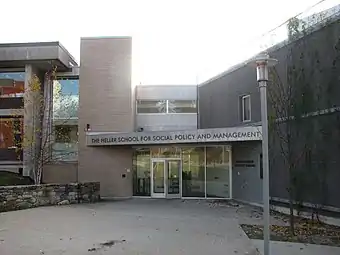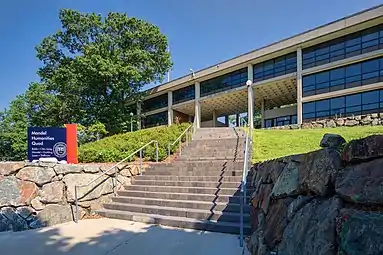Benjamin Thompson (architect)
Benjamin C. Thompson (July 3, 1918 – August 21, 2002), known as Ben Thompson, was an American architect. He was one of eight architects who founded The Architects' Collaborative (TAC) in 1945 in Cambridge, Massachusetts, one of the most notable firms in post-war modernism, and then started his own firm, Benjamin Thompson and Associates (BTA), in 1967.
Benjamin Thompson | |
|---|---|
| Born | July 3, 1918 |
| Died | August 21, 2002 (aged 84) |
| Nationality | American |
| Alma mater | Yale School of Architecture (BArch, 1941) |
| Occupation | Architect |
| Spouse(s) | Mary Okes Thompson (1942–1967 div.) Jane Fiske McCullough (1969–2002) |
| Awards | AIA Gold Medal |
| Practice | The Architects' Collaborative (TAC) Benjamin Thompson and Associates (BTA) Design Research (store) |

Early life and education
Thompson was born in Saint Paul, Minnesota, spent early years on his family's farm, and received his early education at St. Paul Academy and at Avon Old Farms School, a progressive school founded by architect Theodate Pope Riddle in Avon, Connecticut. His interest in architecture was nurtured by travels in Europe with his mother, an artist and art collector. In the fall of 1938 he entered the Yale School of Architecture, where he earned a Bachelor of Architecture degree in 1941. He served for four years in the United States Navy during World War II as a Lieutenant aboard a Destroyer Escort in the North Atlantic and Pacific theaters. He completed his service in the Office of Strategic Services, and provided design services at the United Nations founding conference in San Francisco.
Near the end of the war, Thompson's ship docked in Boston, and he was introduced to Walter Gropius, founder of the Bauhaus School and then head of the Harvard Graduate School of Design. After the war, he moved to Lexington, Massachusetts, where he participated with Gropius and others in the design and creation of Six Moon Hill, a neighborhood of modern houses; his first wife Mary Okes Thompson would live in the Moon Hill house through 2004.
Career
Thompson began his career as an architect in 1946, when he helped persuade Gropius and six other architects to form The Architects' Collaborative (TAC) in Cambridge, Massachusetts.
Design Research


In 1953, he founded Design Research in Cambridge, a company that provided interior furnishings and accessories. Design Research was the first US importer and retailer of the Finnish clothing and textiles of Marimekko. The firm eventually added stores in New York (1964) and San Francisco (1965). In 1969, he designed the company's revolutionary second Cambridge store, notable for its extreme openness and use of glass. In 1970, Thompson lost financial control and ownership of Design Research.
Practice and teaching
Thompson's interest in modernism was balanced by appreciation of older architecture. In the late 1950s, he renovated Harvard Yard's historic dormitories by updating their interior arrangements without visible exterior effect. Shortly thereafter he persuaded Harvard to remodel Boylston Hall (built 1857) rather than demolish it.
During those years, Thompson taught architecture at the Harvard Graduate School of Design, and served as Chair of the Architecture Department 1964-1968. His 1966 essay, “Visual Squalor and Social Disorder”, argued for an urban architecture that would encourage, rather than discourage, joy and social life.[1] To this end, in 1967 he proposed reviving Boston's obsolescent, historic wholesale food markets with food stalls, cafes, restaurants, and pushcarts appealing to the general public.
As TAC grew, Thompson objected to the firm's acceptance of a number of controversial large commissions, including the Pan Am Building atop Grand Central Station in New York City, and the University of Baghdad project, commissioned by Iraq's military regime. He separated from TAC in late 1966 and started his own firm, Benjamin Thompson and Associates (BTA) in 1967. His iconic five-story, all-glass showcase retail store for Design Research was opened in Harvard Square, Cambridge, Massachusetts, in 1968.
Thompson is probably best known for a series of collaborations with the developer James W. Rouse, including the Faneuil Hall Marketplace (Boston, 1976), Harborplace (Baltimore, 1980), South Street Seaport (New York, 1985), Bayside Marketplace (Miami, 1987), and Jacksonville Landing (Jacksonville, 1987).
Honors
Thompson received honorary doctorates from Colby College, the University of Massachusetts Amherst, and Minneapolis College of Art and Design. In 1987, BTA received the AIA Firm Award and in 1992, Thompson received the highest honor in American architecture, the Gold Medal of the American Institute of Architects.[2]
Designs
- Design Research Headquarters in Cambridge, Massachusetts
- Harborplace in Baltimore, Maryland
- South Street Seaport in New York, New York
- Bayside Marketplace in Miami, Florida
- Jacksonville Landing in Jacksonville, Florida
- Faneuil Hall Marketplace, Boston, Massachusetts
Brandeis University
Thompson, working for The Architects Collaborative, designed three major building groups for Brandeis University in Waltham, Massachusetts during an 11-year period beginning 1961.[3] These were the Academic Quadrangle (1961), the Social Science Center (1961, three buildings), and the East Quadrangle (1964). On the occasion of the University's 50th anniversary in 1999, it was observed that "[no other architect] has contributed more to the overall campus image than Benjamin Thompson".[3] Thompson relied on a consistent vocabulary at Brandeis: low horizontal structures with heavy, flat overhanging roofs; structural concrete frames with non-bearing exterior walls; few visual tricks or trendiness; and an "almost Japanese attitude toward composition and siting".[3] Thompson's buildings for Brandeis include:
- David & Irene Schwartz Hall (1961)[3]
- Schiffman Humanities Center (1961)[3]
- Lemberg Hall Day Care Center
- Morris Brown Social Science Center[3]
- Olin-Sang American Civilization Center(1961)[3]
- Golding Judaic Center (1961)[3]
- Rabb Graduate Center (1965)[3]
- Swig Student Center (1964)[3]
- Heller Graduate School for Advanced Studies (1966)[3]
- Lown School of Near Eastern and Judaic Studies (1972)[3]
Gallery
 Lemberg Hall and Social Science Center, Brandeis University (1961)
Lemberg Hall and Social Science Center, Brandeis University (1961) Heller School (1966)
Heller School (1966) Rabb Graduate Center (1965)
Rabb Graduate Center (1965)
Personal life
Benjamin Thompson was first married to Mary Okes Thompson from 1942 to 1967. The Thompsons lived in a house designed by him and built in 1949 on Moon Hill Road in Lexington, Massachusetts. They had five children. In 1959, they purchased a seven-acre waterfront property in Barnstable where the family spent summers together.
Thompson's second marriage was in 1969 to Jane Fiske McCullough, a writer and design critic, who handled his public relations and later became a collaborator on certain of his planning projects. He was Jane's fourth husband. They lived in Cambridge and Barnstable. Ben died in 2002 in his Cambridge home.
References
- Benjamin Thompson, "Visual Squalor and Social Disorder—A New Vision of a City of Man" Architectural Record 145:4:161-164 (1969)
- Branch, Mark Allen (January 1992). "Benjamin Thompson Wins AIA Gold Medal". Progressive Architecture. 73 (1): 21.
- Bernstein, Gerald S (1999). Building & Campus: An Architectural Celebration of Brandeis University 50th Anniversary. Brandeis University Office of Publications. pp. 47–53. ISBN 0-9620545-1-8.
Further reading
- "Ben Thompson", Architecture Boston, Spring 2011 issue, Boston Society of Architects. Issue is dedicated entirely to Ben Thompson with articles by various authors.
- Dunlap, David W., "Benjamin C. Thompson, 84, Architect Of Festive Urban Marketplaces, Is Dead", The New York Times, August 20, 2002